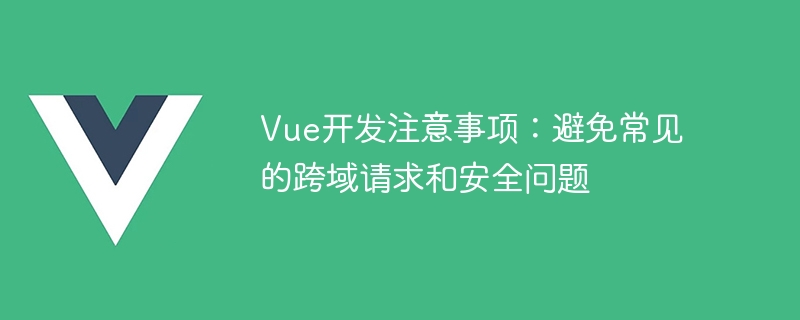

With the continuous development of Internet applications, front-end development frameworks have become increasingly mature. As a popular front-end framework, Vue is appreciated and used by more and more developers. However, during the Vue development process, we need to pay attention to some common cross-domain requests and security issues to avoid possible risks and problems.
1. What is a cross-domain request?
Cross-domain request refers to the process of HTTP data exchange between websites with different domain names or ports. In web development, due to the existence of website security policies, browsers restrict third-party websites from initiating cross-domain requests to the target website. For example, website A (www.a.com) initiates an AJAX request to website B (www.b.com). This kind of request is a cross-domain request.
2. How to avoid cross-domain requests in Vue?
In the Vue project, we can configure webpack-dev-server by devServer.proxy or Vue.config.js devServer.proxy configuration item to set the proxy server for requests. The specific operation is as follows:
// 在Vue.config.js或webpack.config.js中进行如下配置:
module.exports = {
devServer: {
proxy: {
'/api': {
target: 'http://localhost:3000', // 代理服务器地址
changeOrigin: true,
pathRewrite: {
'^/api': ''
}
}
}
}
}As shown in the above code, when the URL we request contains /api, the request will be forwarded to the proxy server for processing.
The proxy server will receive the front-end request and initiate a request to the real API server. When the API server responds, the proxy server returns the data to the front end.
In Vue, you can also install the cross-domain request module, such as using axios to make requests. In axios, we can use the specified request method, URL, request headers and parameters to initiate a request to the server. The specific sample code is as follows:
import axios from 'axios'
axios.get('/api/user')
.then(res => {
// 处理返回结果
})
.catch(err => {
// 处理请求错误
})In the above example, axios will initiate a get request to //localhost:4200/api/user to obtain the corresponding results.
3. How to avoid security risks of Vue applications?
In the development process of Vue applications, in order to prevent attacks and security vulnerabilities that harm the application, we need to pay attention to the following points:
In Vue applications, using outdated or vulnerable versions will bring security risks. To avoid this happening, we should regularly upgrade Vue and related library files to ensure that the application always uses the latest version.
In a Vue application, when rendering a template, HTML strings should not be inserted directly into the DOM. Because this can easily be exploited by hackers to inject malicious scripts and cause attacks on applications. To prevent this from happening, we should use built-in directives or functions for template rendering.
XSS attack refers to an attacker taking advantage of web application vulnerabilities, entering a malicious script into the application, and then executing the script in the user's browser to steal user data . In Vue applications, to avoid XSS attacks, we should filter and encode user-entered data to prevent malicious scripts from entering the application.
To sum up, cross-domain requests and security issues are issues that require special attention in Vue applications. Developers should take precautions as described above to ensure the security and stable operation of applications and provide users with a better user experience.
The above is the detailed content of Vue Development Notes: Avoid Common Cross-Origin Requests and Security Issues. For more information, please follow other related articles on the PHP Chinese website!




